Menus
- Discovery
- In the saddle
- Contact
- In the city
- Highway
- Departmental
- National
- Braking
- Tires
- Duo
- Comfort
- Consumption
- Convenient
- Conclusion
After several sports trials
4 cylinders in 600 cm3 (TT 600 then Daytona 600), Triumph gives up to reveal
finally a sports 600 based on a 3 cylinder: the Daytona
675: an engine developing 106 horsepower at 12,500 rpm (126
horses in free version) for a torque of 7.3 at 11,750 rpm
for a minimum weight of 165 kilos (dry, 187 kilos all full).
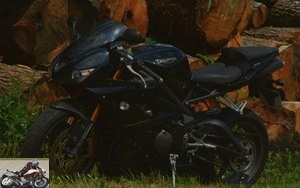
Triumph worked on both a new chassis
and engine: Keihin injection with three 44 mm throttle bodies
in diameter, triple multipoint injectors, control valve
electronic, exhaust valve…
everything must provide – on paper – low power and
mid-range.
Discovery
The Daytona stands out easily within the sport range: look
of sharp shark, triple outlet pot placed under the
saddle.
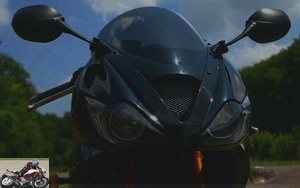
The dashboard features a huge analog tachometer, overlooking
a digital counter (lacking readability in use),
the totalizer and a partial double trip. On the left a digital screen,
integrating a real on-board computer offers: clock,
maximum speed, instantaneous consumption, average consumption,
number of kilometers traveled, water temperature,
stopwatch (for use on the track) … The gear indicator
engaged is a real plus.

In the saddle
The Daytona immediately sets you up to climb on the perched saddle
to 825 mm. You have to lift your leg very high to go up! Once
in the saddle, the feet barely touch the ground for the 1.70m pilot,
despite the narrow saddle. The handlebars being lower
than the saddle, the position is immediately completely
tilted forward, with very strong support
on the cuffs. The Daytona immediately shows its difference
at the driving position level.
On the other hand, the legs are placed nicely around the tank
and the feet instinctively find their position on the footrests.
The saddle being long, you can choose your position, more or less
lying down, with or without being back.
Its light weight and placed low is no problem
at a standstill or at low speed.
Contact
The pot immediately rumbles. The counter resets,
including with the blue diodes on the right of the meter. The start
is carried out with the clutch engaged.
The motorcycle starts on a trickle of gas, immediately providing sensations
by a full engine at the bottom. The serious sound of the exhaust
contribute to giving real pleasure from the first laps
of wheels, while the first accelerations
make the pilot vibrate again with this characteristic turbine noise
of the 3 Triumph cylinders.
The box turns out to be fluent, precise and pleasant.
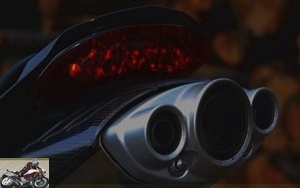
In the city
The motorcycle is easy to handle and sneaks around easily,
aided by light weight and excellent handling.
The Daytona accepts without complaint all the modes: in first
up to 100 km / h or in 6th gear, at 2,000 rpm at
40 km / h. It can even wind at 1,500 rpm but growls
despite everything a little up to 2,000 rpm, speed
on which she is already leaving with a certain vitality.
That said, traffic jams quickly strengthen the pressure on
wrists, turning driving into torture. The cuffs strongly
solicited are broken. The heat of the engine and the pot heat up
exaggeratedly under the buttocks. In short, driving in the city
must be reduced to ten minutes, time to go out
and find the roads again, under penalty of rapid cooking.
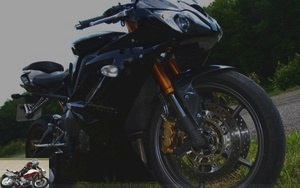
Highway
The Daytona soars with force and vigor on the highway,
exceeding the speed limit in a few seconds, and
another 2,000 rpm from the red zone! Wind pressure on the bust
then lightens the pressure on the wrists and the Daytona becomes
pleasant. The speeds then change to reach revs
unmentionable. Large curves are taken naturally and without any
effort. The bubble protects extremely well up to
speeds allowing you to lose your license. The Daytona is unfazed
whatever the speed, and yet, even at very
high speed, it allows all maneuvers and overtaking
easily. Where some sportswomen reveal themselves
hard to move, the Daytona accepts all course changes,
without renouncing to an exemplary holding of course. The whole
is particularly reassuring.
The Daytona 675 here takes a huge advantage over
the previous model, which tended to
have the front lighter at high speed and
didn’t make you particularly confident at high speeds.
Here, it is quite the opposite: the Daytona is very
reassuring, even at high speed: a real push to crime
and temptations to lose your license … especially since
if the tachometer is clearly visible, the speedometer is not
not particularly visible, with easily annoying reflections
his reading.
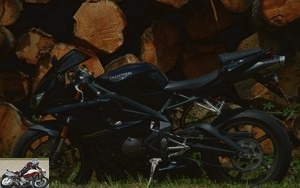
Departmental
Even though the Daytona excels on the highway, it can’t wait
virolos. She comes down here in regime, while being
able to stay on 6th when driving … very curled up.
But if the rhythm must accelerate, and the alternations
of accelerations and braking are linked
quickly, she will appreciate going down two or even three gears.
It can then go up in a lively and regular way
in the towers up to 9,000 rpm, then actually
unleash beyond 10,000 rpm and practically
until the red zone. It remains in control until
9,000 rpm and requires good control beyond that, while
being easy to use. Because its demonstrative engine
everywhere, equips an impeccable chassis without any bad
reaction.
It is easily placed in a curve, without requiring any particular effort.
The position resting on the wrists is an asset here,
forcing a good position with bent arms, and favoring
good downforce, further improving handling.
In the event of an overly optimistic entry into a curve, it accepts everything
also easily late course corrections to get out
cleanly and without risk, thus making it possible to refine its piloting
as it is used. The indented saddle
also allows you to move easily to position yourself in the best possible way. In short,
she asks for more, with exemplary behavior.
All complemented by the fabulous sound of three in one in three,
that accompanies each acceleration and deceleration,
in a serious and powerful way … captivating! We never tire of
mill.
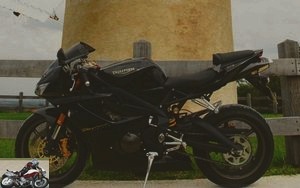
National
We go up here one or two reports to wind up, while allowing
fast and efficient overtaking, as long as you
or above 5,000 rpm. We will just notice a few vibrations
above 8,000 rpm without this being prohibitive.
She is however able to wind quietly on the reports
intermediates at mid-speed with pick-ups under
the particularly vigorous 90 km / h in particular compared to
to some four cylinders. What, make it more livable and
more lively in road use.
Braking
The rear brake is a good retarder, allowing
to seat the motorcycle, without being able to block, even in
forcing. The front brake offers both a good feeling and
power, without being exaggerated, especially with regard to
machine performance. It turns out on the other hand
enduring and we can therefore solicit them without worry. The whole gives a braking
easy to handle, but which deserves a bit of bite
in addition. We notice in passing the braided brake hoses.
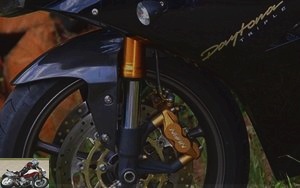
Tires
The Daytona is equipped with Pirelli Super Corsa. The hook
proves good in dry conditions, and just requires a little more attention
in the rain, due to the lack of profile on the angle.
Duo
The passenger seat is high … peaking at more than one
meter from the ground! To such an extent, moreover, that there
has only one way of going up, relying on one
footrests. The passenger then towers above the pilot with a
perfectly clear view. Continuity, bubble, pilot
and passenger provides fairly good protection also to the
passenger who will not suffer from the speed or the wind. On the other hand, it
there is no handle. The power of the motorcycle encourages
sporty driving, and even being careful when starting
and braking, the passenger tends to move backwards
or forward, causing very rapid fatigue. Despite
the height, the weight of the passenger does not change the behavior of the motorcycle
; at most we feel a front significantly lighter, but without
excess.
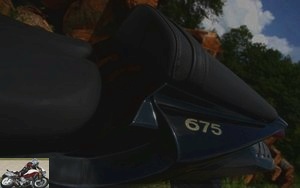
Comfort
The saddle – rather thin – is a board and the suspensions
are particularly dry. Suddenly, both driving
is pleasant on good roads, it becomes difficult on
damaged road. In short, the Daytona is a real
sporty, exclusive, without effort of comfort, neither for the pilot and again
less for the passenger.
Consumption
At stabilized speed, with a mix, motorway, national and departmental,
consumption is 5.5 liters per hundred (test average).
By way of comparison, on the same route / identical pace, the
Daytona consumes 5.7 liters respectively where an ER-6
consumes 4.5 liters, and 5.2 liters where an ER-6 consumes
from 3.9 liters.
Being in 6th gear, at 90 km / h, on the flat, fuel consumption
can even drop below 5 liters per hundred. But the use
sporty that the motorcycle encourages to have tends to have rather
an average consumption of 7 liters per hundred, or even increase
at 9 liters per hundred in intensive use.
In which case, instead of falling on the reserve between 235 and 250
km, the reserve will be reached before the 200 km.
The on-board computer providing both consumption
average per 100 km and instant fuel consumption is
particularly reliable in use.
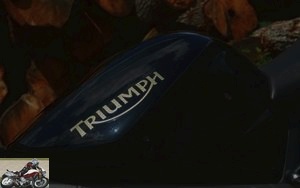
Convenient
The Daytona is a sports car and has no practicality
: no place under the saddle to house an anti-theft device, no hooks for
stow some luggage in the rear seat … we find, however,
straps under the passenger seat.
On the other hand, for those who manage to transport a U, the one
willingly placed in the front or back.
The passenger seat can be removed … using a key
allen, once the rider saddle has been removed … but offers no
place for anything anyway.
On the other hand, we appreciate the detail of the angled tire valves.
at 90 °, very practical for a clean pressure measurement.
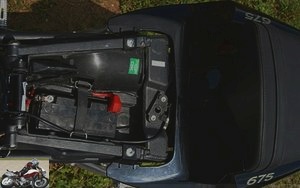
Conclusion
The market was waiting for a real alternative to sports
Japanese. Triumph finally offers it, with more than an alternative,
a real choice, at a particularly well placed price
at 10,390 €, placing her as one of the sports
600cc the cheapest on the market. And for that price, she
offers real personality, both on the
aesthetic plan and especially motorization. The engine is a treat
in terms of performance and character (without forgetting a captivating sound)
magnificently assisted by its cycle part. She earns more
to be known, the driving pleasure is gained as and
for miles … outside the city. She
can then reveal its full potential and open up to the pilot the
joys of a particularly well-born sportsman 600…
Strong points
- Engine: torque and approval
- Behviour
Weak points
- Saddle height
- Exclusive position
- Comfort
Competitors: Ducati 848, Honda 600 CBR,
Suzuki GSX-R 600, Triumph Daytona 675R, Yamaha R6
Datasheet
| Reader essays on
the Testing forum
An essay by David Morcrette
Related articles
-
Suzuki DL 650 VStrom motorcycle test
Small GT with a big heart The DL 650 is the little sister of the DL 1000: a V-shaped twin cylinder with 90 ° of 650 cm3. Born a year after her big sister…
-
Triumph Tiger 1050 motorcycle test
A 4-day trial over 1,100 km The Triumph Tiger had taken a sacred look of old over the years, especially compared to the new Varadero and VStrom, despite…
-
Yamaha FZ1 Fazer S 1000 motorcycle test
The Swiss Army Knife sharpened – test in five 2007 vintage days Initially launched in 2000, the FZ1 has massively evolved in its new vintage. Still from…
-
Yamaha Fazer FZ6 motorcycle test
The GT roadster The Fazer has been completely revised for its edition 2004, Euro2 standard obliges. In fact, the new model has nothing to do with its…
-
Triumph Tiger 955 motorcycle test
In order to respond present in all categories, Triumph presented in 1993 a big road trail, XXL version: the Tiger. Powered by a 3-cylinder 885 cc…
-
Honda Hornet 600 – CB600F 2007 vintage motorcycle test
Ten-day test of the 2007 vintage Exit on the heels of the wicked roadsters ago more than 9 years, the CB600F Hornet has been completely revised in 2007….
-
Triumph Sprint ST 955i motorcycle test
Long-distance Sport-GT The Sprint ST is one of those road cars with a zest sporty, allowing long journeys to be combined with thrills day by day. And…
-
Zero SR / S electric motorcycle test
Z-Force battery of 14.4 kWh, Torque 190 Nm, 229 kg, € 21,700 Quiet Watts ! It has been a few years since electric motorcycles arrived on the market, Zero…
-
Aprilia Shiver 750 SL motorcycle test
2008 vintage The Shiver is Aprilia’s big novelty in the villainous 750 cc roadster segment in 2007. It quickly evolved in 2008 with 3 handlebar behavior…
-
1,800-kilometer test Unveiled in 2004, the Honda CBF 600 offers a basic motorcycle, versatile and accessible to young drivers. In 2008, it benefited from…